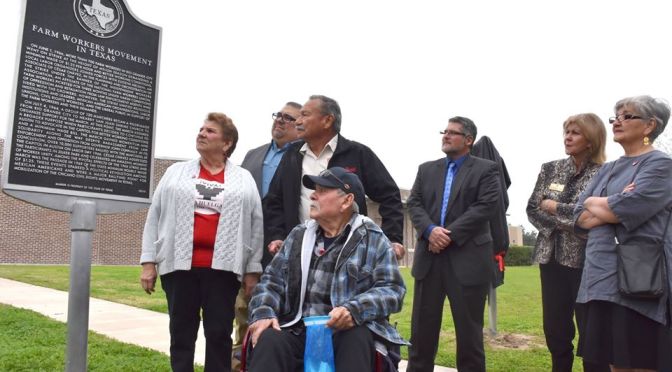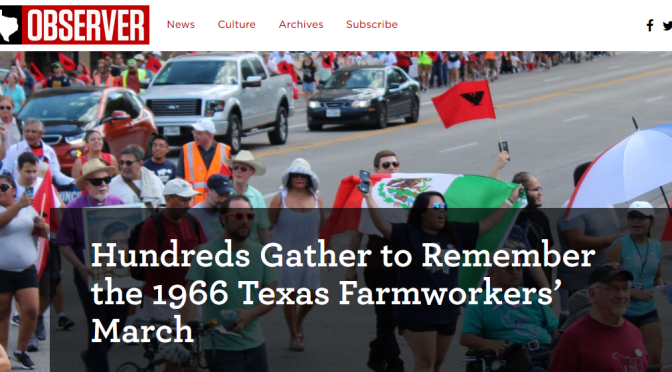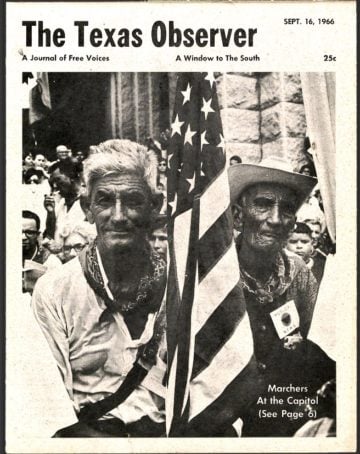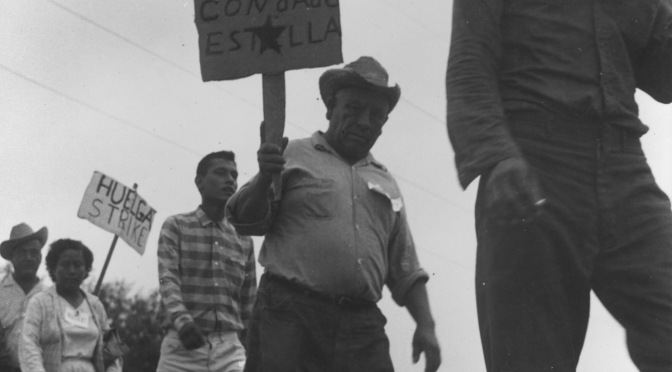Marcha de los Campesinos
Río Grande City,Texas, 1966
© by Nephtalí De León
miren mi pueblo querido
lo que les voy a contar
comenzó en Río Grande City
en el condado de Starr
hace 40 y 10 años
sucedió algo muy extraño
cuando la gente del campo
dijo al Gringo —
ya no nos jodas tú tanto
pagaban en el melón
40 cobres por hora
a misery 40 cents
donde la vida del pobre
and their energy was spent
ahí no había coffee break
ni tampoco where to poop
si querías el escudao
nomás se veían las matas
que las hacíamos pa’ un lado
esto tiene que cambiar
decía Domingo Arredono
simón dijo el Balde Díaz
a los miembros del committee
no somos la piris wiris
con gente neta del pueblo
Rodrigo y Pedro García
se arrimó la Daría Vera
con la Kathy y Magdaleno
Librado y Alex Moreno
firmaron con sangre limpia
que viva La Raza mía !
aquí no nos hacen caso
vamos a píe al capitolio
a ver al gobernador
saquen sus chanclas más gruesas
las de cuero son mejor
arrestaron a unos cuantos
pero nadie se awitó
algunos aquí presentes
recuerdan mejor que yo
como el Efraín Carrera
que no andaba a las carreras…
yo también tuve en l’hotel
de la carcel de Río Grande
por andar de Nicky Snick
en el highway 83
keep it between you and me
en forma de Texas Rangers
les cayó chota gabacha
decía la Raza valiente
no importa que traigan bacha
tan babosos como el jelly
y se llaman Captain Allee
1/3 of the people arrested
eran mujeres valientes
que no se olvide esta historia
nuestras mujeres en gloria
marcadas en la memoria
dicho y hecho se nos van
desde Río Grande visitan
a la Virgen de San Juan
Medeiros el Portugues
gives them a great big mass
cuando llegan a Edcouch Elsa
les hacen un Barbeque
ya pasaron Weslaco
y les sigue Raymondville
y van a pasar por Linn
los periódicos los siguen
tanto humano en el camino
en la lluvia y en el sol
el Bene Treviño traiba
a sus dos hijas valientes
Graciela era la mas grande
13 años llevaba Herminia
Lupita Guzmán mas leve
apenas con 29
se les acaban las chanclas
y Falfurrias les regala
18 par de zapatos
y en kinisville, La Quineña
se dejan caer la greña
con los vaqueros de Tejas
Carlos Guerra reportero
escribe cosas bonitas
y en Robe, en el Robestown
los que piscan algodón
they throw their cotton sack down
y acompañan a la gente
del mero Río Grande town
sigue Corpitos, Normanna, Kennedy,
Beeville y Karnes city, with a big time
Raza rally — in downtown Floresville
where the governor is from
but he did’nt dare to come
the missions of San Antonio
give them such a juicy welcome
bajo el Arzobispo Lucy
but it’s raining cats and dogs
on Aug 27 que la falda de Daría
ran its beautiful bright green
her legs become neon green
craziest scene you´ve ever seen !
they give him tools of their trade
a canteloupe and some cotton
3,000 gather to march
from historic Milam Park
to the famous Alamó ,
this was 50 years ago,
where Methodist Joel Martinez
before an astounded nation
gives the holy invocation
they finally reach New Braunfels
where they´re met by tres amigos
who act like their enemigos
Attorney General Wagonner Carr
Speaker of the House Ben Barnes
y el mero Gobernador John Connally !
los tres pa’ decir que no!
Dijo Fernando Piñón
all those cheers turned into jeers
undaunted they kept their march
past New Braunfels, past San Marcos
y en la Uni de San Eduardo
en la mera capital
15 thousand people waited
to welcome the campesinos !
Cesar Chavez was presente
con toda la linda gente
también estaba Ann Richards
Ralph Yarborough senador
y la gente de calibre
luchando pa un pueblo libre
with 15,000 behind them
together the last 4 miles
they find the capital of Texas
for the first time in it´s life
with giant chains and a padlock
pos que creía el mandatario
que de Río Grande salieron
super hembra y superman
no los dejaron entrar
ni tampoco pos cambiar
40 centavos l´hora
por un salario cabal
aquí se acaba la historia
de valientes campesinos
humilde y tan pobre gente
pos cambiaron el destino
la gente empezó a luchar
por todo el estado de Texas
hubo huelgas, hubo marchas
hubo walkouts, hoteles organizados,
y hasta nacieron las boinas
los famosos Brown Berets
hubo un movimiento humano,
de los 40 centavos,
pedían uno y veinte y cinco
el puro mínimum wage
dejen decirles señores
dejen decirles señoras
que´l salario lo cambiaron
4 años después de este acto
a un dolar con cuarenta
despues de aquel digno día
hace medio siglo exacto
gracias a la valentía
del migrante campesino
que se oiga todos los días
que la viva la Raza mía !
email : nephtali3000@hotmail.com
website : — http://Nephtali.Net






















